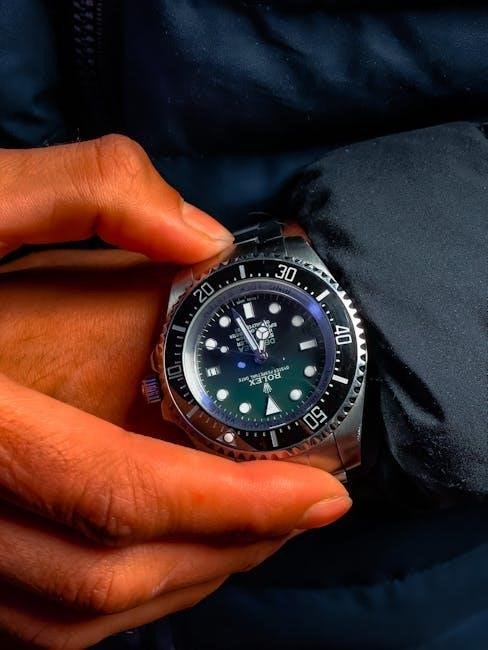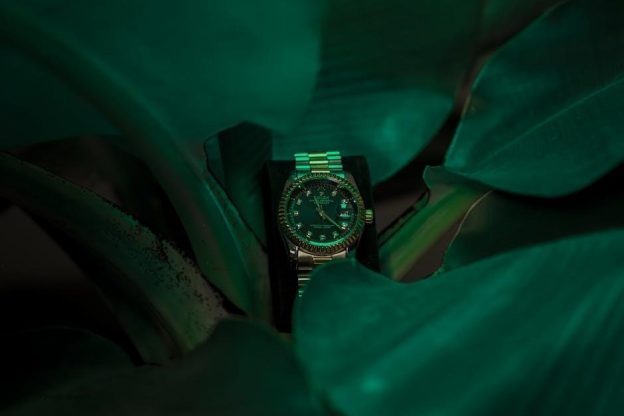Rolex watches embody timeless elegance and precision, symbolizing luxury and reliability. With a rich history and commitment to excellence, they remain iconic in the world of horology.

History and Background of Rolex
Founded in 1905 by Hans Wilsdorf and Alfred Davis in London, Rolex initially specialized in importing Swiss movements. The name “Rolex” was registered in 1908, symbolizing a desire for excellence. In 1919, the company relocated to Geneva, Switzerland, solidifying its Swiss heritage. Rolex pioneered innovations like the first waterproof watch, the Oyster, in 1926, and the Perpetual Rotor in 1931, revolutionizing automatic winding. These milestones established Rolex as a leader in watchmaking, blending precision, durability, and style. Its commitment to quality and innovation has made Rolex synonymous with luxury timepieces globally.
Rolex’s Reputation in the Watch Industry
Rolex is renowned for its unwavering commitment to excellence, earning a prestigious reputation in the watch industry. As a symbol of luxury and precision, Rolex timepieces are sought after globally. The brand’s dedication to innovation and craftsmanship has set high standards, making it a benchmark for others. Its iconic designs, such as the Submariner and Daytona, are celebrated for their functionality and elegance. Rolex’s reputation is further bolstered by its association with exploration, sports, and culture, sponsoring events like the Daytona 500 and Wimbledon. The brand’s focus on quality and heritage ensures its timepieces remain timeless classics, cherished by collectors and connoisseurs alike.
Key Design Elements and Philosophy
Rolex’s design philosophy revolves around simplicity, functionality, and timeless elegance. The brand is known for its clean, symmetrical aesthetics, emphasizing legibility and practicality. Iconic elements like the Oyster case, Cyclops lens, and sporty bezels define Rolex watches. The use of high-quality materials and meticulous craftsmanship ensures durability and sophistication. Rolex’s philosophy prioritizes evolution over revolution, maintaining classic designs while incorporating modern innovations. This approach has solidified Rolex as a symbol of reliability and style. The brand’s dedication to precision and performance is evident in every detail, from the robust movements to the ergonomic bracelets. Rolex’s design philosophy ensures that each timepiece remains a testament to horological excellence, blending tradition with contemporary refinement.

Popular Rolex Watch Models
Rolex offers iconic models like the Submariner, Daytona, and GMT-Master, each celebrated for its unique design, functionality, and enduring appeal, reflecting timeless craftsmanship and versatility.
Rolex Submariner: Features and History
The Rolex Submariner, introduced in 1954, is a legendary diver’s watch renowned for its robustness and underwater capabilities. Initially designed for deep-sea exploration, it features a unidirectional rotating bezel to track dive times and a water resistance of up to 300 meters. Over the years, the Submariner has evolved, incorporating advancements like the use of Oystersteel for durability and improved movement accuracy. Its sleek design, with a minimalist dial and luminescent hour markers, has made it a favorite among both divers and watch enthusiasts. The Submariner’s iconic status is further enhanced by its association with James Bond films, solidifying its place as a symbol of adventure and sophistication.
Rolex Daytona: The Iconic Chronograph
The Rolex Daytona, introduced in 1963, is a premier chronograph watch designed for racing enthusiasts. It features a tachymeter bezel for calculating average speeds, making it a favorite among motorsport professionals. The Daytona’s design emphasizes functionality with its three subdials for minutes, seconds, and hours, while maintaining a sleek, sporty aesthetic. Initially with a manual-wind movement, it later evolved to an automatic caliber, enhancing user convenience. The Daytona’s cultural impact grew when it became associated with Paul Newman, leading to the nickname “Paul Newman Daytona,” which commands high value among collectors. Its precision and durability have solidified its reputation as a cornerstone in watchmaking history, blending performance with timeless style.

Rolex GMT-Master: The Aviator’s Watch
The Rolex GMT-Master, introduced in 1954, was designed for aviation professionals, enabling them to track multiple time zones simultaneously. Its iconic two-tone bezel, featuring a 24-hour scale, became a hallmark of the model. Initially developed for Pan American Airways pilots, the GMT-Master quickly gained popularity beyond aviation circles. The watch’s functionality, combined with its robust design, made it a favorite among global travelers. Over the years, the GMT-Master has evolved, incorporating advancements like the Calibre 3180 movement, while retaining its timeless appeal. Its ability to display three time zones—home, destination, and a third via the rotating bezel—solidified its reputation as a tool watch for the modern era. The GMT-Master’s blend of utility and style has made it a cornerstone in Rolex’s collection, celebrated by watch enthusiasts worldwide.
Rolex Datejust: Timeless Elegance
The Rolex Datejust, unveiled in 1945, is a quintessential expression of timeless elegance. It was the first watch to feature an automatically changing date display, a groundbreaking innovation at the time. Known for its simplicity and versatility, the Datejust is available in a variety of materials, including Rolesor, Oystersteel, and 18kt gold. Its iconic design elements, such as the Cyclops lens and Jubilee bracelet, have become synonymous with Rolex’s heritage. The Datejust appeals to both men and women, with sizes ranging from 28mm to 41mm. Over the decades, it has remained a symbol of sophistication, making it one of Rolex’s most beloved models. Its enduring appeal lies in its ability to seamlessly blend functionality with classic style, ensuring it remains a staple in any watch collection.
Rolex Watch Materials and Craftsmanship
Rolex crafts watches using Oystersteel, Rolesor, and 18kt gold, ensuring durability and elegance. Each piece undergoes meticulous manufacturing, reflecting the brand’s dedication to precision and timeless quality.
Oystersteel: Rolex’s Stainless Steel Alloy
Oystersteel, Rolex’s proprietary stainless steel alloy, is known for its exceptional corrosion resistance and durability. This high-quality material is used in Rolex watches for its robustness and polished finish, ensuring longevity and timeless appeal. It is developed to withstand harsh environments, making it ideal for both everyday wear and extreme conditions; Rolex’s commitment to excellence is reflected in the precision and craftsmanship of Oystersteel, which maintains its luster and strength over time. This alloy is a testament to Rolex’s dedication to innovation and quality, ensuring that each timepiece remains a reliable companion for years to come. Oystersteel is a key component in Rolex’s reputation for creating watches that are both functional and elegant.
Rolesor: The Blend of Steel and Gold
Rolesor is Rolex’s innovative combination of stainless steel and gold, offering a harmonious blend of durability and luxury. Introduced in the 1930s, it symbolizes Rolex’s commitment to both functionality and elegance. The steel provides strength and resistance to corrosion, while the gold adds a touch of sophistication and timeless appeal. Rolesor is used in various Rolex models, creating a balanced aesthetic that appeals to a wide range of tastes. This unique alloy is a testament to Rolex’s craftsmanship, ensuring a refined and versatile timepiece. The combination of materials makes Rolesor watches both practical and stylish, perfect for everyday wear or special occasions. Rolex’s attention to detail in blending steel and gold underscores its dedication to creating watches that are both beautiful and enduring. Rolesor remains a cornerstone of Rolex’s design philosophy, embodying the brand’s legacy of innovation and excellence.
18kt Gold: Yellow, White, and Everose Gold
Rolex’s 18kt gold watches are crafted from the finest precious metals, offering exceptional elegance and durability. Yellow gold, the classic choice, exudes warmth and timeless sophistication. White gold, often paired with diamonds or other gemstones, presents a sleek, modern aesthetic. Everose gold, a proprietary alloy exclusive to Rolex, combines a subtle reddish hue with remarkable resistance to tarnish, creating a unique and captivating appearance. Each gold variant is carefully alloyed in-house to ensure superior quality and consistency. Rolex’s 18kt gold watches are not only stunning but also highly durable, making them a symbol of luxury and refinement. The meticulous craftsmanship and attention to detail in each piece underscore Rolex’s commitment to excellence, ensuring these timepieces remain treasured possessions for generations. The blend of traditional beauty and modern innovation defines Rolex’s 18kt gold collection, making it a cornerstone of haute horlogerie.

Rolex Movements and Precision
Rolex movements exemplify precision and reliability, with in-house calibers meticulously crafted for exceptional timekeeping. Each movement underscores Rolex’s engineering excellence and commitment to accuracy and durability.
In-House Movements: Calibers and Innovations
Rolex’s in-house movements are a testament to their commitment to precision and innovation. The Caliber 3255, for instance, boasts a 70-hour power reserve and exceptional accuracy. Similarly, the Caliber 2236 integrates a silicon Syloxi hairspring, enhancing resistance to magnetic fields and temperature variations. These movements undergo rigorous testing, ensuring they meet the highest standards of reliability and performance. Rolex’s dedication to innovation is evident in their Chronergy escapement, which improves efficiency by 15%. Additionally, the Parachrom hairspring, made from a unique alloy, provides superior stability in extreme conditions. Each movement is meticulously assembled by skilled watchmakers, reflecting Rolex’s legacy of horological excellence. Their in-house calibers are not just timekeeping instruments but masterpieces of engineering and craftsmanship.
- Caliber 3255: 70-hour power reserve.
- Caliber 2236: Silicon Syloxi hairspring.
- Chronergy escapement: 15% efficiency improvement.
- Parachrom hairspring: Magnetic and temperature resistance.
Chronograph Movements: Precision and Complexity
Rolex’s chronograph movements are renowned for their precision and intricate design. The Daytona, for example, features a robust column-wheel mechanism, ensuring smooth operation of its stop-start and reset functions. These movements are built with high-performance materials, such as the proprietary Chronergy escapement, which enhances energy efficiency. The vertical clutch system prevents the hands from jumping when the chronograph is activated, maintaining accuracy. Rolex’s commitment to engineering excellence is evident in the meticulous assembly and adjustment of each component. Every movement undergoes rigorous testing to meet the brand’s high standards. The combination of technical innovation and craftsmanship makes Rolex chronographs highly sought after by watch enthusiasts and collectors alike.
- Column-wheel mechanism for smooth operation.
- Vertical clutch system for precise activation.
- Chronergy escapement for improved efficiency.
Certified Chronometers: The COSC Standard
Rolex watches adhere to the stringent COSC (Contrôle Officiel Suisse des Chronomètres) certification, ensuring exceptional timekeeping accuracy. This independent testing verifies that each movement meets precise standards, tolerating only minimal deviations. Rolex submits its movements to COSC for a 15-day evaluation, during which they are tested in various positions and temperatures. This rigorous process guarantees that every Rolex timepiece maintains an average daily accuracy of -4 to +6 seconds. The COSC certification is a hallmark of Rolex’s commitment to precision and reliability, reinforcing its reputation as a leader in watchmaking. This dedication to excellence ensures that Rolex watches remain accurate and dependable for years to come.
- COSC certification ensures high accuracy.
- 15-day testing in multiple conditions.
- Maximum deviation of -4 to +6 seconds daily.
